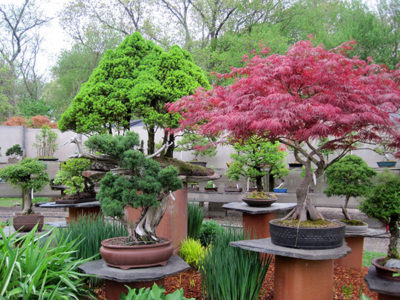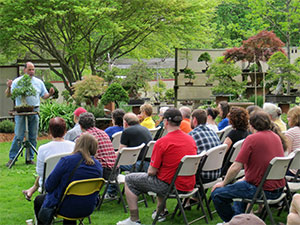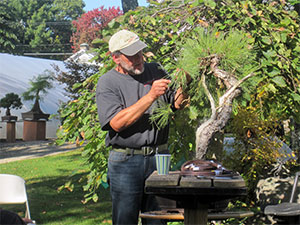Four Seasons of Bonsai: Summer
 July-August
July-August
Summer is here, and with it comes the beginning of the second of our three New England growing seasons (we divide the growing season up into thirds: April-June; July-August; September–October). It’s time to make sure that we are on target for certain growing goals and making the most of our short summer.
July is a beautiful growing month with its long days and cool evenings. Trees are still continuing to grow. Because of this they are drinking water more than ever and everyone should be on the alert to avoid a dry-out. Some of our root-bound trees need to be dunked in a wheelbarrow full of water to insure that their roots get saturated.
 All the tropicals are vigorously growing and we are pruning them back hard, even defoliating many of them. The advantage to heavy leaf pruning this time of year is that they are growing so fast that they bud back almost immediately. The new leaves come in smaller and more compact and replace the older, often blemished, leaves that had increased in size because of being indoors all winter. Remember leaves increase in size when they are not getting enough light so with the intense summer sun trees create tiny leaves perfect for bonsai.
All the tropicals are vigorously growing and we are pruning them back hard, even defoliating many of them. The advantage to heavy leaf pruning this time of year is that they are growing so fast that they bud back almost immediately. The new leaves come in smaller and more compact and replace the older, often blemished, leaves that had increased in size because of being indoors all winter. Remember leaves increase in size when they are not getting enough light so with the intense summer sun trees create tiny leaves perfect for bonsai.
At the same time that tropicals are exploding with new growth many of our cold-hardy trees will begin to shut down toward the end of July. I like to think of this as a mini dormant period for deciduous trees and many conifers such as pines. It’s important to move maples out of the direct sun, and to be careful not to over-water trees that seem to be drinking slowly. We check our trees everyday for water however we only water when needed. And skip over trees that are not drinking as much—if you wind up with a couple of sick or weak trees in your collection it is very important to move them to another spot, a sick bay if you will, so you can monitor them separately.
 Somehow we think of the lazy days of August as a slow time for bonsai activity. Nothing could be further from the truth. We are rushing around the nursery trying to finish up some of the important summer chores, including transplanting our root bound tropical bonsai.
Somehow we think of the lazy days of August as a slow time for bonsai activity. Nothing could be further from the truth. We are rushing around the nursery trying to finish up some of the important summer chores, including transplanting our root bound tropical bonsai.
When deciding whether or not to transplant your tree look at its health. Remember: if you don’t re-pot during the next month you should wait until next summer. Our general rule of thumb is: if the pot looks too small, or if the foliage is not vibrant, if the tree seems to have stopped growing, or if it has been hard to keep up on the watering even with daily watering—then it is probably due for a root pruning, otherwise wait another year.
At the same time, pruning all of your tropicals is very important now so that they won’t be spindly during the winter. A good pruning now will promote vigorous new healthy leaves.
- August is also a great time to put your trees up on a turntable and inspect each one individually.
- Check for insects that could be hiding under leaves or in the bark.
- Spray with a preventative insecticide or treat with a good systemic.
- Remove all debris that may have fallen from surrounding trees and do a thorough weeding.
- Prune the occasional wild branch, remove scorched leaves, and thin out drooping branches on Juniper. Shimpaku juniper also have a tendency to shed their inner foliage and turn yellow, this is another place insects hide and should be cleaned.
- Be careful not to prune Azalea, Wisteria, Camellia, or any trees that set their next year’s flower buds in the fall.
- Use your fingers or a wire brush to clean the trunk and roots, you will be surprised how well trees respond to being touched.
 The end of summer is always a sad time for me, and it always feels like it went by too fast.The crickets are louder at night, the purple fireweed is in full bloom, hay fever sufferers begin to notice the pollen and our bonsai trees prepare for the last third of our short but very productive New England growing season.
The end of summer is always a sad time for me, and it always feels like it went by too fast.The crickets are louder at night, the purple fireweed is in full bloom, hay fever sufferers begin to notice the pollen and our bonsai trees prepare for the last third of our short but very productive New England growing season.
Summary of tips
- Pines need to be in full sun, candles need to be pinched, do not over water
- Old flower buds on azaleas should be removed, including the little stem
- Bud pinch all junipers
- Repot and prune tropicals
- Move maples into semi shade
- Fertilize everything well
- Remove old wire before it cuts the bark
- Separate healthy and weak trees; healthy trees are drinking daily, weaker trees drink less
- Elm trees should be pruned back hard
- Weed everything
- Brush bark to clean it
- Rotate trees on benches to receive more light on back sides
- Pull up a chair, relax, enjoy all of your trees and your hard work